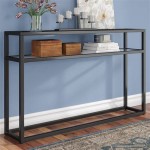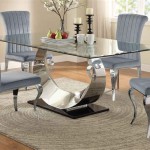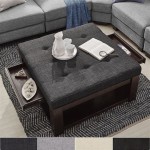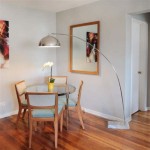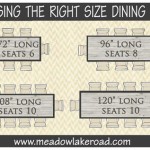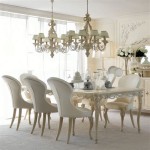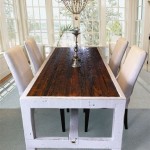Best Tables For Small Spaces: Maximizing Functionality and Style
In contemporary living, particularly in urban settings, space is often a premium. Efficiently furnishing these compact environments is crucial for maintaining both functionality and aesthetic appeal. Tables, an essential component in any dwelling, require careful consideration when space is limited. This article explores various types of tables that are ideally suited for small spaces, presenting a comprehensive overview of their attributes and applications.
The selection of a table for a small space involves a multifaceted approach. Factors such as the table's dimensions when both collapsed and extended (if applicable), its inherent style, the material composition, the intended purpose, and the overall weight must be carefully weighed. A poorly chosen table can clutter the space, hinder movement, and ultimately detract from the room's intended ambiance, whereas an optimally chosen table can contribute greatly to the overall flow and utility of the room.
Folding Tables: Versatility in a Minimal Footprint
Folding tables represent one of the most practical solutions for maximizing space flexibility. These tables are designed to be easily collapsed and stored when not in use, freeing up valuable floor area. They are particularly beneficial in rooms that serve multiple purposes, such as a living room that occasionally transforms into a dining area or a home office that needs to be cleared for other activities. Folding tables can be constructed from a variety of materials, including wood, metal, and plastic, with each material offering its own advantages in terms of durability, weight, and aesthetic qualities. The folding mechanisms vary, but commonly involve hinges and locking mechanisms to ensure stability when the table is in use. Furthermore, the storage footprint of a folding table is generally minimal, allowing it to be tucked away behind furniture, under a bed, or in a closet.
The design of folding tables has evolved significantly. Models are available that feature intricate folding mechanisms, allowing for adjustments in height or surface area. Some folding tables are even designed to be wall-mounted, further minimizing their impact on floor space when not in use. The design considerations of a particular folding table should factor in the load it will support, the frequency of its use, and the aesthetic integration with the surrounding decor. Heavy-duty folding tables are suitable for regular use and can support heavier items, while lighter-weight folding tables are better suited for occasional use and lighter loads. Selecting a table with a style that complements the existing furniture helps to create a cohesive and harmonious overall appearance.
Consider the intended purpose of the folding table when evaluating different models. A folding dining table should be large enough to comfortably accommodate the expected number of diners, while a folding desk should provide ample surface area for a laptop, documents, and other necessary work materials. Furthermore, consider the ease of folding and unfolding the table. A table that is cumbersome to operate may discourage its frequent use. Opt for models with smooth, reliable folding mechanisms that can be easily managed by a single person.
Drop-Leaf Tables: Adapting to Changing Needs
Drop-leaf tables offer a different approach to space optimization. These tables feature hinged leaves that can be raised or lowered to adjust the surface area. When the leaves are lowered, the table occupies a minimal footprint, making it ideal for small rooms. When the leaves are raised, the table provides a larger surface for dining, working, or other activities. This adaptability makes drop-leaf tables a versatile choice for apartments, studios, and other compact living spaces. The design of drop-leaf tables can vary considerably, ranging from traditional styles with intricate detailing to modern designs with clean lines and minimalist aesthetics.
The functionality of a drop-leaf table hinges on the stability of the supporting mechanism for the leaves. Traditionally, these mechanisms have involved hinged legs or brackets that swing out to support the leaves. Modern designs may incorporate more sophisticated locking mechanisms to ensure that the leaves are securely in place when raised. The quality of these mechanisms is crucial for the table's long-term performance. A poorly designed or constructed supporting mechanism can lead to instability and sagging, compromising the table's usability. Before buying a drop-leaf table, thoroughly inspect the supporting mechanisms and ensure that they are robust and reliable.
Drop-leaf tables are often constructed from wood, but they can also be found with metal or glass accents. Wooden drop-leaf tables offer a classic and timeless appeal, and they can be easily integrated into a variety of decor styles. Metal accents can add a touch of modernity to a drop-leaf table, while glass surfaces can create a sense of spaciousness. Consider the overall design aesthetic of the room when choosing a drop-leaf table. A table that complements the existing furniture and decor will enhance the overall ambiance of the space.
The size and shape of a drop-leaf table should also be carefully considered. Round drop-leaf tables are often a good choice for small spaces, as they can be easily maneuvered around. Rectangular drop-leaf tables offer a more traditional look, and they can be a good option for rooms with a more formal decor. When selecting a drop-leaf table, take into account the number of people who will typically be using the table, and choose a size that comfortably accommodates everyone. Also, consider the placement of the table in the room. Ensure that there is enough space to easily raise and lower the leaves without obstructing doorways or other furniture.
Nesting Tables: Layered Functionality and Compact Storage
Nesting tables present a clever solution for maximizing functionality while minimizing storage space. These tables consist of a set of two or more tables of varying sizes that fit neatly inside each other. When not in use, the smaller tables can be stored completely beneath the larger table, occupying a minimal footprint. When needed, the smaller tables can be easily pulled out and used as side tables, coffee tables, or even temporary work surfaces. Nesting tables are particularly well-suited for living rooms, bedrooms, and other areas where space is at a premium. The design of nesting tables can range from simple and minimalist to more elaborate and decorative styles.
The construction materials of nesting tables play a crucial role in their durability and aesthetic appeal. Wood, metal, glass, and acrylic are common materials used in the construction of nesting tables. Wooden nesting tables offer a warm and inviting feel, and they can be easily customized to match the existing decor. Metal nesting tables provide a more modern and industrial look, and they are often very durable. Glass nesting tables can create a sense of lightness and spaciousness, while acrylic nesting tables offer a contemporary and transparent aesthetic. When choosing nesting tables, consider the overall style of the room and select materials that complement the existing furniture and decor.
The size and shape of nesting tables should also be carefully considered. Generally, smaller spaces benefit from having tables with rounded edges, as they allow for easier movement throughout the space. A common layout consists of either completely circular or rectangular tables that fit snuggly inside the larger table. The height difference between the tables should be sufficient to allow the smaller tables to be easily pulled out and used without interfering with the larger table. A set of nesting tables that are too large or too tall can feel bulky and cumbersome, defeating the purpose of space optimization.
Beyond their practical functionality, nesting tables can also serve as decorative elements. The varying heights and shapes of the tables can create visual interest, and they can be used to display plants, books, or other decorative items. Consider the color and finish of the nesting tables. A set of nesting tables with a vibrant color or a unique finish can add a pop of personality to the room. Conversely, a set of nesting tables with a neutral color and a simple design can blend seamlessly into the existing decor.
When placing nesting tables, consider the layout of the room and the intended use of the tables. In a living room, nesting tables can be placed near a sofa or armchair to provide convenient surfaces for drinks, snacks, or books. In a bedroom, nesting tables can be used as bedside tables. In a home office, nesting tables can provide extra workspace when needed. Experiment with different arrangements to find the configuration that best suits the needs of the space.
Console Tables: Slim Profile, Maximum Impact
Console tables are narrow, elongated tables that are designed to fit against a wall. Their slim profile makes them ideal for hallways, entryways, and other narrow spaces where a larger table would be impractical. Despite their compact size, console tables can provide valuable surface area for displaying decorative items, holding keys and mail, or even serving as a temporary workspace. Console tables come in a wide variety of styles, ranging from traditional designs with ornate detailing to modern designs with clean lines and minimalist aesthetics. The functionality of a console table is often enhanced by the addition of drawers, shelves, or other storage features.
The choice of material for a console table is crucial for both its durability and aesthetic appeal. Wood, metal, glass, and stone are common materials used in the construction of console tables. Wooden console tables offer a warm and inviting feel, and they can be easily integrated into a variety of decor styles. Metal console tables provide a more modern and industrial look, and they are often very durable. Glass console tables can create a sense of lightness and spaciousness, while stone console tables offer a luxurious and sophisticated aesthetic. When choosing a console table, consider the overall style of the room and select materials that complement the existing furniture and decor.
The height and length of a console table should be carefully considered. A console table that is too tall can feel imposing, while a console table that is too short may not provide enough surface area. The length of the console table should be proportional to the length of the wall against which it will be placed. A console table that is too long can overwhelm the space, while a console table that is too short may look out of place. A general rule of thumb is to choose a console table that is approximately two-thirds the length of the wall.
The style of a console table should complement the overall decor of the room. In a traditional setting, a console table with ornate detailing and a rich wood finish would be a good choice. In a modern setting, a console table with clean lines and a minimalist design would be more appropriate. Consider the color and finish of the console table. A console table with a bold color or a unique finish can add a pop of personality to the room. Conversely, a console table with a neutral color and a simple design can blend seamlessly into the existing decor.
Accessories can further enhance the functionality and aesthetic appeal of a console table. A mirror placed above the console table can create a sense of spaciousness and reflect light into the room. A lamp placed on the console table can provide ambient lighting and add warmth to the space. Plants, books, and other decorative items can be used to personalize the console table and reflect the owner's style.

Six Of The Best Small Space Dining Tables Bright Bazaar By Will Taylor
The Best Small Space Dining Tables That Can Double As Work Desks

The 5 Best Dining Tables Of 2025 Reviews By Wirecutter

The 38 Best Coffee Tables For Small Spaces In 2024 Domino

What Coffee Tables Are Best For Small Space

21 Best Small Dining Tables For Every Budget 2025 Glamour
15 Best Dining Tables For Small Spaces

13 Awesome Diy Dining Tables For Small Spaces Ohmeohmy Blog

The 5 Best Coffee Tables For Small Spaces Pulp Design Studios

Which Dining Tables Are Best For Small Spaces Furniture Co

